Troy, Pergamon, Hierapolis, or Ephesus: Choosing The Right Archaeological Site – Turkey
categories: asia travelWhen visiting the contemporary nation of Türkiye, there are numerous Greco-Roman archaeological sites to see. Attempting to explore all of these locations may lead to some serious “antiquities fatigue,” similar to the cathedral burnout that many travelers experience in Europe. I encountered this challenge during my travels with my wife and two close friends.
We participated in a group tour of the Turkish countryside, which included visits to four significant Greco-Roman sites over the course of four days: Troy, Pergamum, Hierapolis, and Ephesus. As an admirer of Roman history, this presented a perfect opportunity to explore locations I had yearned to visit since my university years. However, for my family, friends, and other tour participants, this experience quickly turned into an ordeal.
The issue arose from their inability to see each site’s unique characteristics and contextualize their historical significance. To them, it felt as though they were witnessing the same site repeatedly. Should you find yourself in a similar predicament while exploring Türkiye or any other former Roman territory, I have compiled some insights and recommendations regarding each site we visited to assist you in determining what may be most suitable for your travels.

The entrance to the excavations at the Historical National Park at Troy
Troy
Many people are familiar with the famous tale of the Trojan Horse and the storied city of Troy. Indeed, there was a historical city by that name that thrived from ancient times through the Greco-Roman period. Troy faced numerous destructions due to warfare and earthquakes, only to be reconstructed at least ten times or more.
The present archaeological site is stratified into ten distinct layers, each representing a city built upon the remnants of its predecessor. In 1871, the infamous archaeologist Heinrich Schliemann conducted excavations at this site and proclaimed that while excavating layer VIII, he had discovered the walls of the ancient city depicted in Homer’s Iliad. Today, visitors to this UNESCO World Heritage archaeological park primarily observe a series of excavations that have occurred over many years.
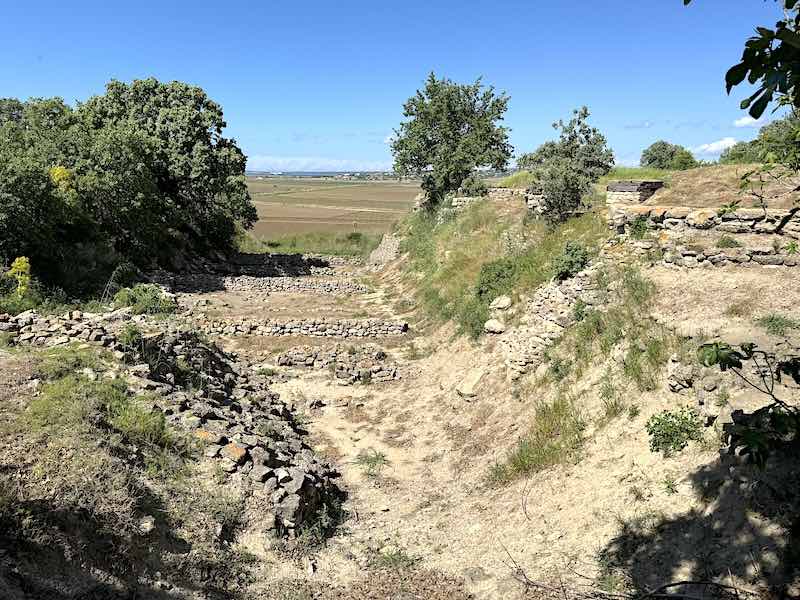
Heinrich Schliemann famous excavation trench cutting through the various layers of settlements at Troy
Heinrich Schliemann
Heinrich Schliemann was a 19th-century German archaeologist and businessman best known for his groundbreaking excavations of the ancient city of Troy. Driven by a passion for classical literature, particularly Homer’s epics, Schliemann set out to prove the historical reality of the Trojan War. Despite criticism of his excavation methods, which damaged some of the site’s layers, Schliemann’s work profoundly influenced the field of archaeology. His later excavations included significant discoveries at Mycenae, where he unearthed the famous “Mask of Agamemnon.”
The majority of the remains consist of the foundations of city walls and structures, which, to most visitors, may appear as an assortment of stones and bricks. I was excited to visit the archaeological site of Troy, although I must admit that this location is primarily suited for travelers who have a profound interest in the Iliad or the work of Heinrich Schliemann. Currently, the site features a network of boardwalks and paths that facilitate access to the various excavations conducted over the years.
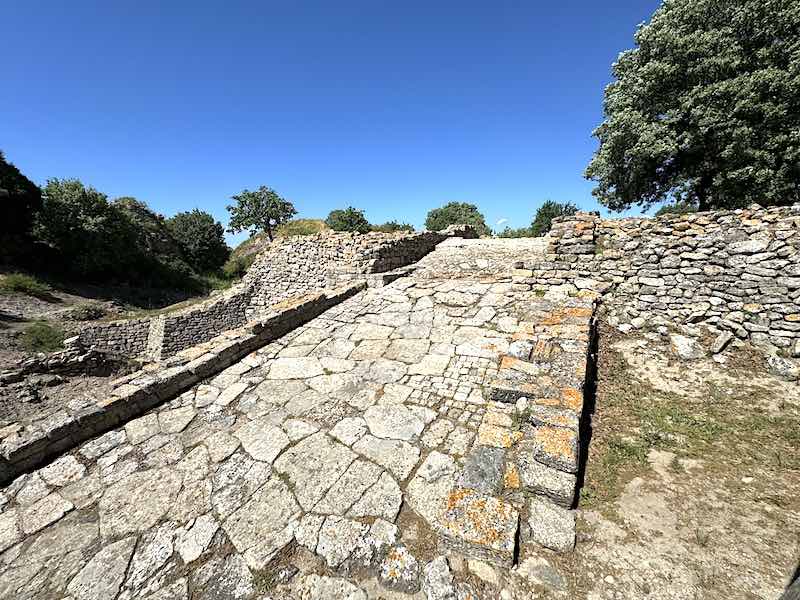
A reconstructed entrance ramp to the southeast area of the city of Troy found in the excavations of Layer II
A leisurely stroll through the meandering trails provides a comprehensive view of the site, with informative signs and placards detailing the findings. The experience is undoubtedly enriched by the presence of a knowledgeable guide with a vivid imagination who can compellingly recount the story of Troy. During our visit, there were limited resources to help visitors envision Troy in its ancient splendor, and even a replica of the iconic Trojan Horse was undergoing reconstruction.
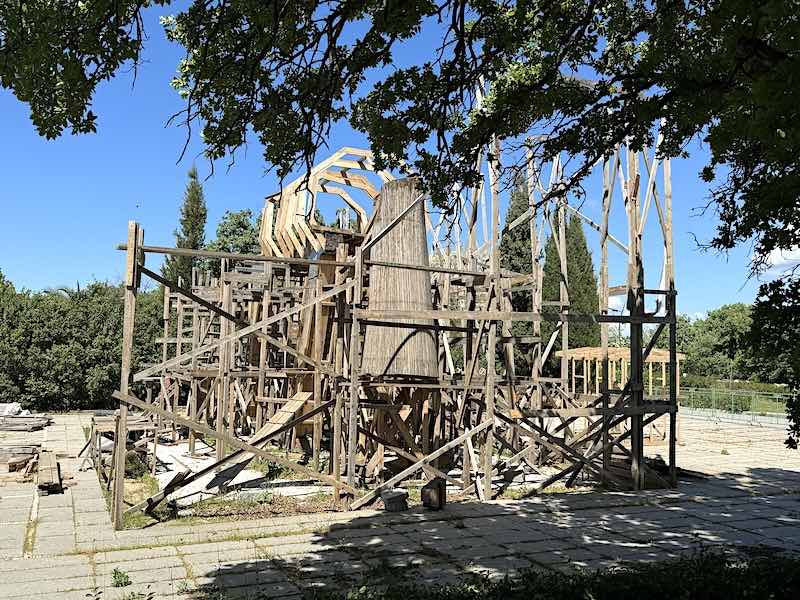
A replica of the Trojan Horse under reconstruction at the Historical National Park at Troy
The Historical National Park at Troy presented a challenge for my group, who primarily perceived it as merely a collection of stones and bricks. Several individuals expressed their disappointment over the absence of a Trojan Horse. Despite my attempts to clarify that the tale of the Trojan Horse is likely a myth and any wooden statue from that period would have surely disintegrated into dust by now, they still wanted to see the horse.
Conversely, I was eager to witness Schliemann’s famous excavation trench. Having previously admired the treasures of Priam at the Pushkin Museum in Moscow, it was exhilarating to visit the actual site of their discovery. Unfortunately, most members of our group left feeling underwhelmed. For those who are enthusiasts of Homer’s Iliad and Odyssey or have a strong interest in Schliemann’s work, this site is undoubtedly worth a visit.
However, if you are traveling with family or a group, some prior preparation may be beneficial to help everyone appreciate the historical significance of the ancient ruins. The park also features a museum and a well-stocked gift shop offering various souvenirs to commemorate your visit to Troy. Hopefully, the replica of the horse will be rebuilt by the time of your visit.
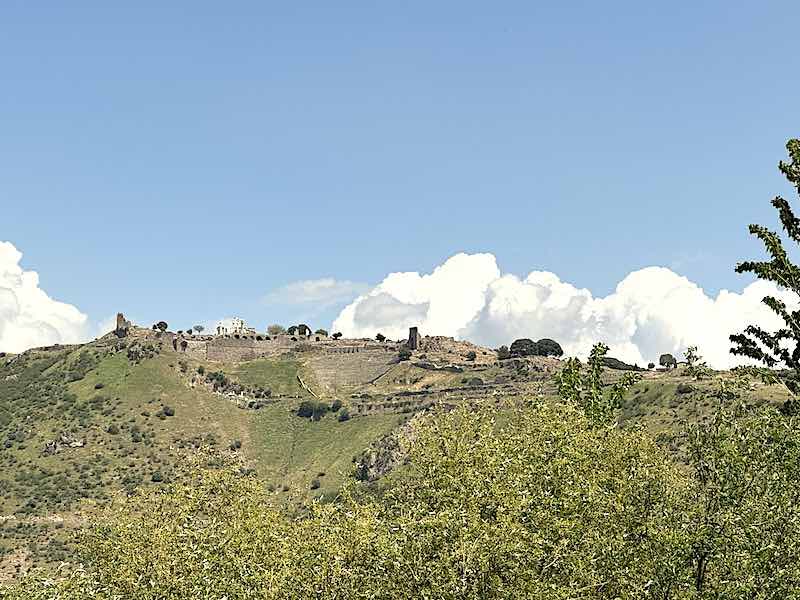
The Upper and Lower Acropulises of Pergamon
Pergamon
The ancient city of Pergamon represents a significant Greco-Roman site that continued to thrive during the Byzantine Period. This city boasts a rich history that can be traced back to the archaic era. Situated inland, it is located in a hilly and mountainous region, away from the sea.
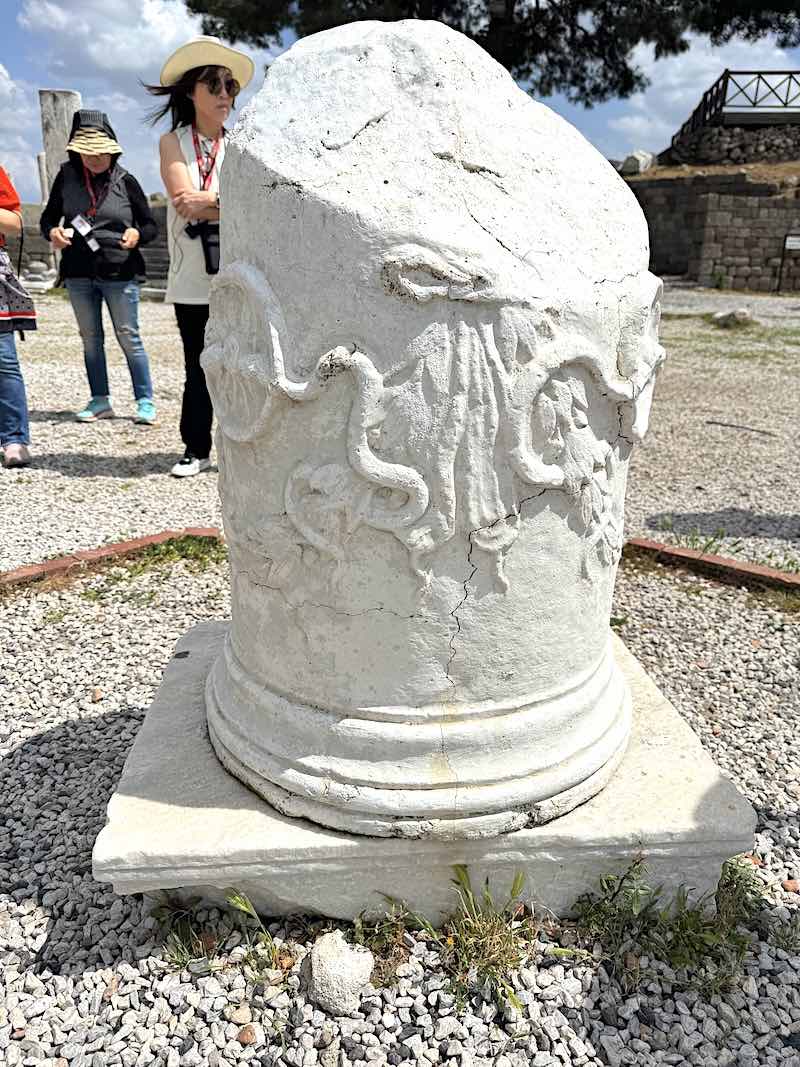
A monument at the Asclepieion featuring serpents associated with the art of healing
Pergamon is characterized by its division into an upper and lower acropolis and the Sanctuary of Asclepius, commonly known as the Asclepieion. The Asclepieion is the most frequented site due to its accessibility. The Upper and Lower Acropolises are perched atop a steep hill, which can be reached via challenging walking paths or a cable car.
The most renowned feature of this site is the Altar of Pergamon, excavated by the German engineer Carl Humann in 1878. A significant portion of the altar’s frieze was transported to Berlin, where it was reconstructed and is now displayed in the Pergamon Museum. Regrettably, the Pergamon Museum is undergoing renovations and will remain closed until at least 2037.
If you want to view any remnants of the altar, particularly the foundations located in the Upper Acropolis, you will need to visit Pergamon itself. For those with a strong interest in Pergamon, it is advisable to allocate an entire day to explore the site thoroughly and to devise a strategy for optimizing your visit. A highly recommended approach is to utilize the Bergama Acropolis Gondola to ascend to the Acropolis and then make your way down on foot.
The remnants of Pergamum visible today are predominantly Roman. The acropolis, situated atop a mesa, showcases the city’s oldest structures. An advisable way to begin your exploration is at the foundations of the Great Altar, which was likely dedicated to the deities Zeus and Athena.
Another notable feature is the remarkably preserved Hellenistic theater, constructed steeply into the hillside and could accommodate up to 10,000 spectators. Additionally, the acropolis contains the foundations and some columns of the Temple of Trajan, where both Zeus and Trajan were venerated.
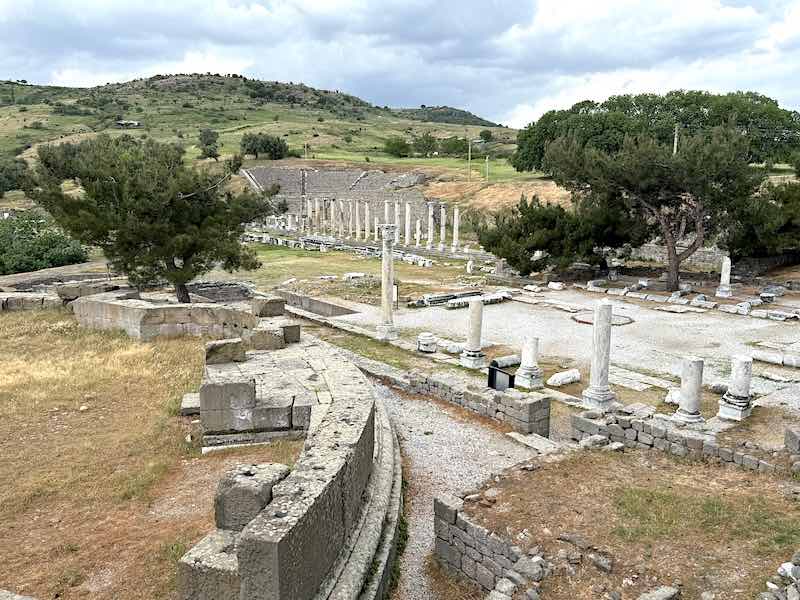
The main agora of the Asclepieion taken from the circular healing center
Visitors can also observe the staircase and foundation of the Sanctuary of Dionysus and the remnants of the oldest temple, the Sanctuary of Athena. Furthermore, you will encounter various foundations and partial colonnades of a library, palace, agora, and shrines, along with the remains of a bath complex. Lower on the hill lies the lower acropolis, which includes a gymnasium and sanctuaries dedicated to the goddesses Hera and Demeter.
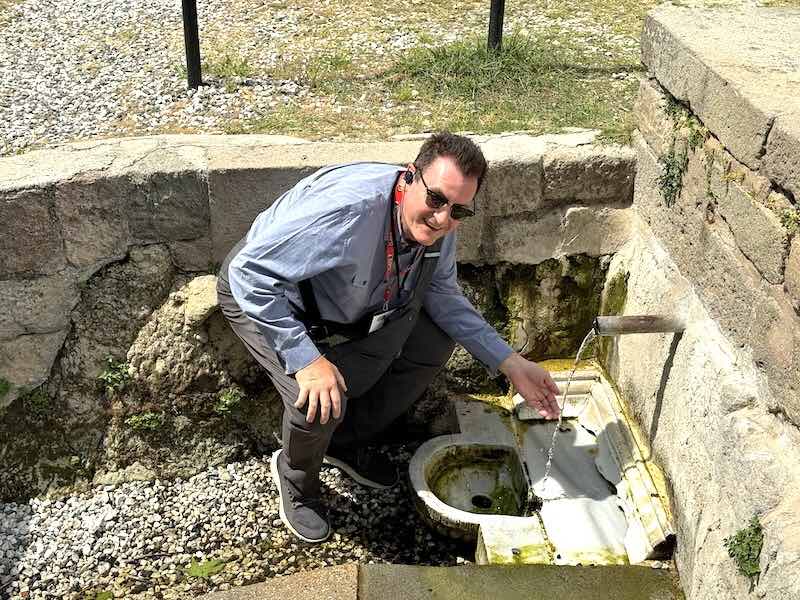
Sampling water from the sacred healing spring of the Asclepieion
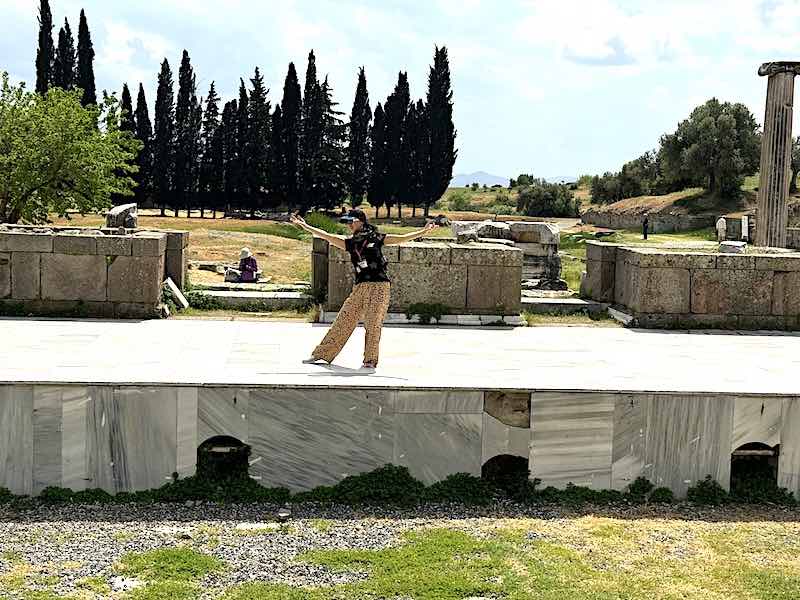
The stage of the small theater found within the grounds of the Asclepieion
The Asclepieion, dedicated to Asclepius, the deity of healing, is located approximately three miles south of the Acropolis. Patients would visit the complex to immerse themselves in the waters of a sacred spring, hoping for divine guidance from Asclepius through dreams regarding their ailments. Notably, Galen, the preeminent physician of the Roman Empire and personal doctor to Emperor Marcus Aurelius, practiced here for many years.
Today, as in ancient times, individuals enter the complex via the colonnaded sacred pathway known as the Via Tecta. Within the site, visitors can observe the remnants of a circular treatment center, a healing spring, an extensive underground passage, a library, several stoas, a theater, and the Temple of Asclepius. The archaeological site of ancient Pergamon is vast and warrants a full day for exploration.
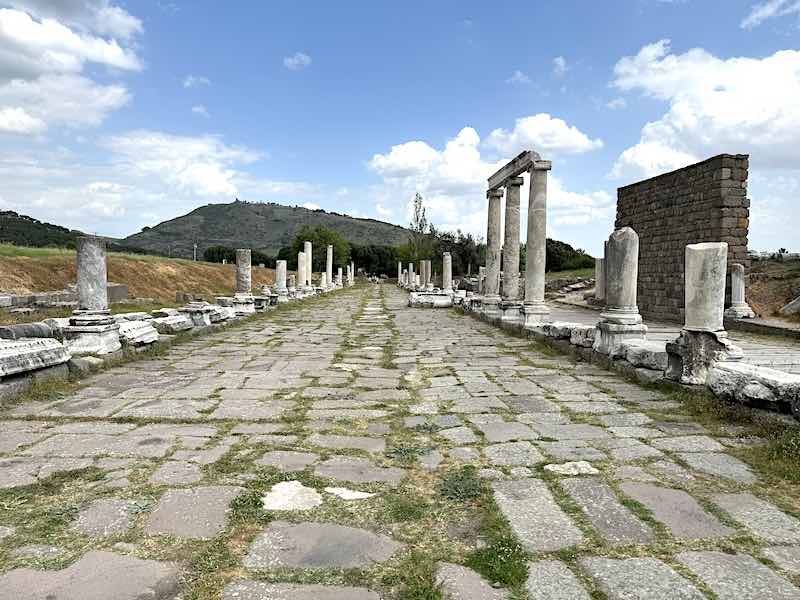
The Via Tecta, the colonnaded sacred pathway entrance to the Asclepieion at Pergamon
Visitors can easily spend several hours at both the Acropolis and the Asclepieion, both of which merit thorough investigation if time permits. During my visit, our group dedicated approximately two and a half hours to the Asclepieion, but unfortunately, we could not allocate sufficient time to explore the Acropolis.
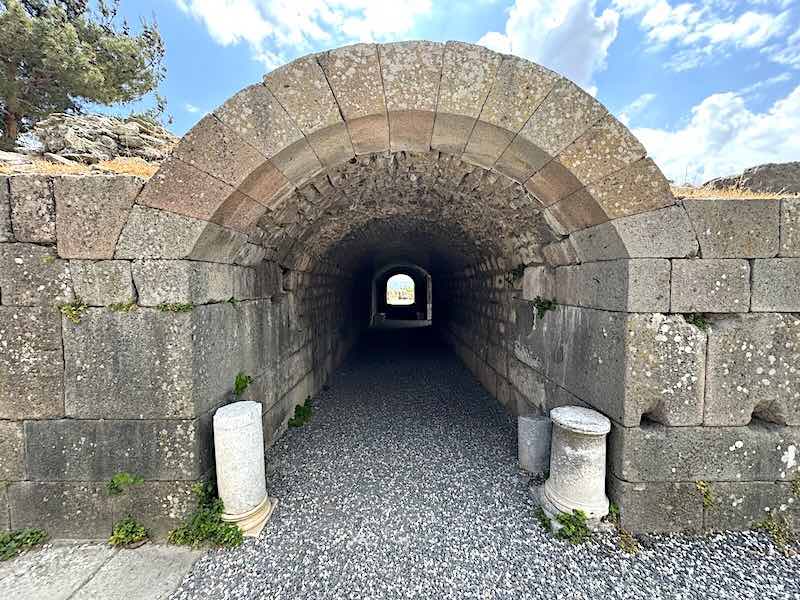
One of the underground passageways for patients found throughout the Asclepieion
The Acropolis demands a greater investment of time and effort than the Asclepieion, as reaching the hill’s summit requires additional transportation. Our guided tour of the Asclepieion captivated the group, highlighting its well-preserved theater and numerous colonnades alongside the remnants of various structures. The extensive underground tunnels used for patient care added an element of intrigue to the experience.
My group had a general awareness of Pergamon’s history, and we visited it before Ephesus, which contributed to their overall satisfaction with the experience. The site offered more than mere foundations; the presence of colonnades and theaters allowed everyone to envision it as a vibrant historical location.
Pergamon is a commendable site that will likely be less crowded than Ephesus. Our guided tour significantly enhanced our understanding of the extensive ruins. I strongly recommend visiting this site. Additionally, there is a museum in Bergama that showcases statues and artifacts unearthed during excavations conducted after World War I.
Notably, the most remarkable artifacts are housed in the Pergamon Museum in Berlin, which, did I mention, is currently closed for renovations until at least 2037.
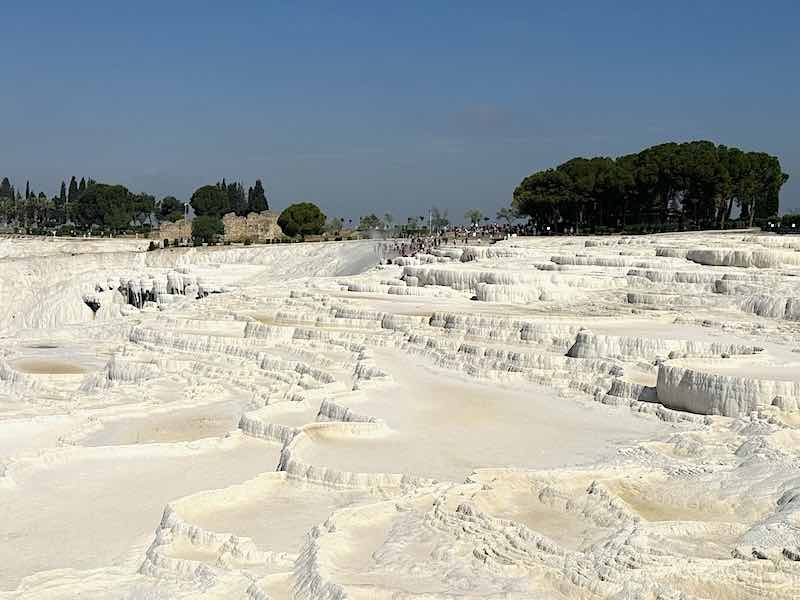
The travertine terraces of Pamukkale
Hierapolis
When exploring the Turkish countryside, a visit to Hierapolis is likely on your itinerary. This is not solely due to an interest in this ancient Roman city but rather because it is near Pamukkale. The two locations share the same geographical area and ticketing office.
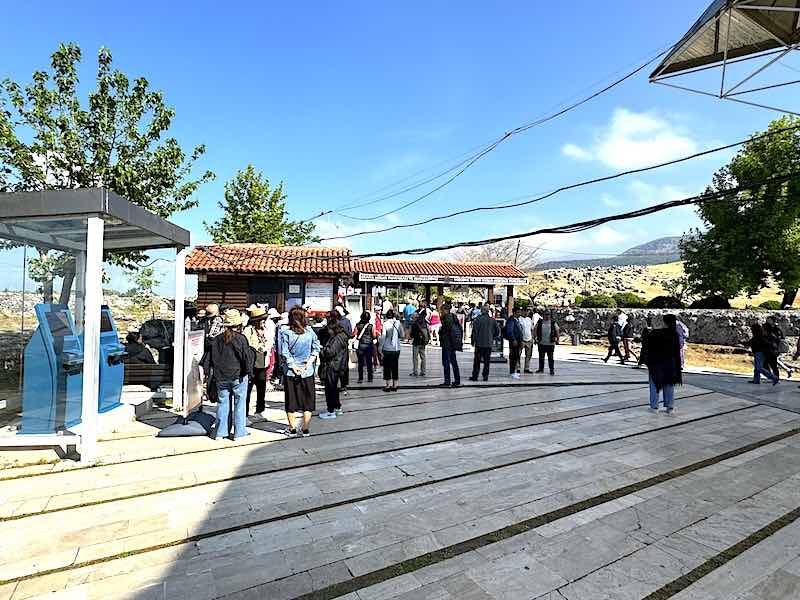
The ticketing and information center found at the entrance to Hierapolis and Pamukkale
Hierapolis was established as a Hellenistic Greek city renowned for its famous hot spring. The therapeutic use of these hot springs dates back to the 2nd century BCE. The city is often overshadowed by the striking geological formation of travertine limestone terraces known as Pamukkale, which translates to “cotton castle” in Turkish.

The theater at Hierapolis on a hill overlooking the town and Pamukkale
In 133 BCE, Hierapolis became incorporated into the Roman province of Asia. Following a devastating earthquake in 17 CE, the city was reconstructed in a Roman architectural style under the direction of Nero. Subsequent emperors contributed additional structures, including a theater and Roman baths.
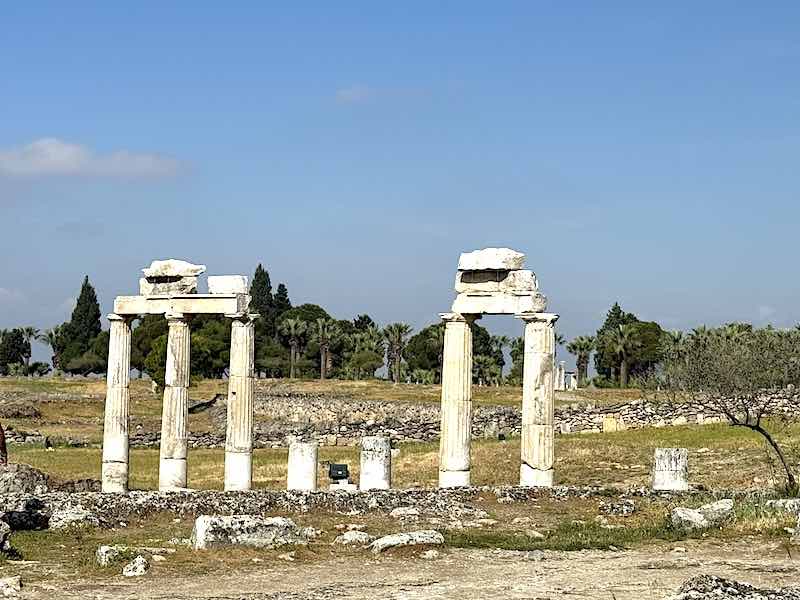
Remnants of one of the few colonnades still standing in Hierapolis
Unfortunately, later invasions by Persian forces and further seismic activity have resulted in the collapse of many ancient structures. The site was excavated in 1887 by the German archaeologist Carl Humann, who also excavated Pergamon. Interest in the site has surged in the past two decades, largely due to the development of Pamukkale as a distinctive tourist destination.
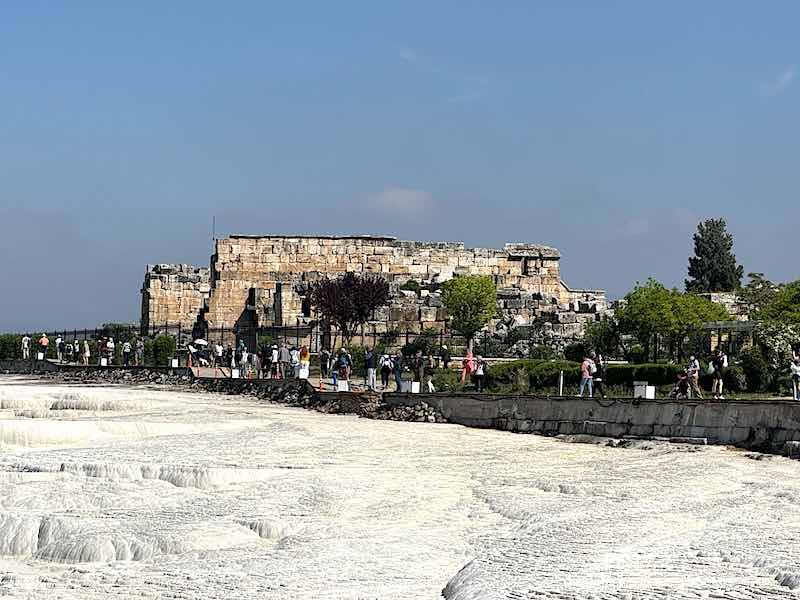
The thermal baths of Hierapolis overlooking the travertine terraces of Pamukkale
While some restoration efforts have been made, visitors will primarily encounter a landscape of stones and fallen columns, with minimal reconstruction that makes it challenging to envision the city in its entirety. Hierapolis boasts several notable sites worth visiting. The most impressive is the Roman theater, which accommodated 15,000 spectators and is situated on a hill overlooking the ancient city center.
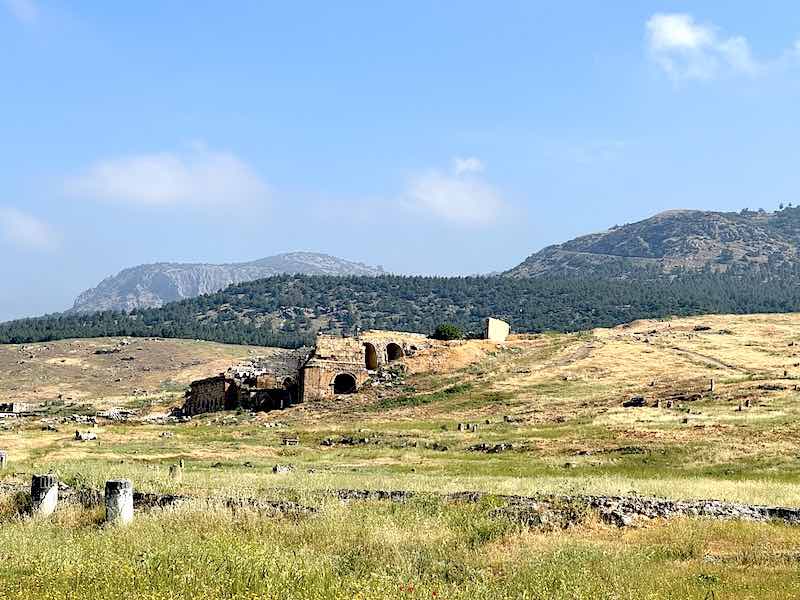
The scattered stones of the city of Hierapolis showing the theater in the background
This theater was likely built during Hadrian’s reign, sometime after 60 AD. Its uniqueness lies in the preservation of much of the scaenae frons, and from the theater’s summit, one can enjoy a picturesque view of Hierapolis, Pamukkale, and the surrounding landscape. The ascent to the theater is certainly worthwhile.
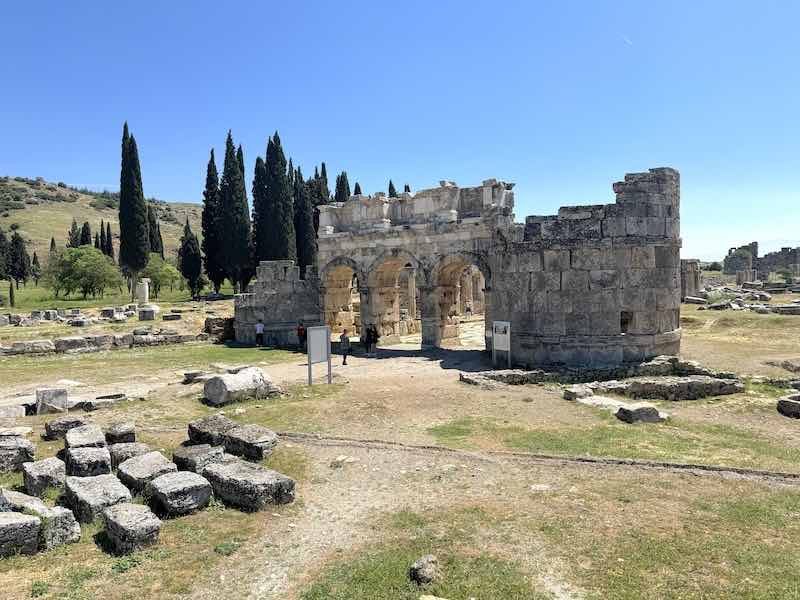
The Frontius Gate at leading into the western side of Hierapolis
Additionally, the Basilica Baths are noteworthy as they currently serve as an archaeological museum, displaying artifacts from various nearby Roman settlements. Visitors can also explore the remnants of city gates, including the Domitian and Frontinus Gates, as well as fragments of the Temple of Apollo. Among the most significant attractions is the necropolis, which stretches from the northern to the eastern and southern parts of the ancient city.
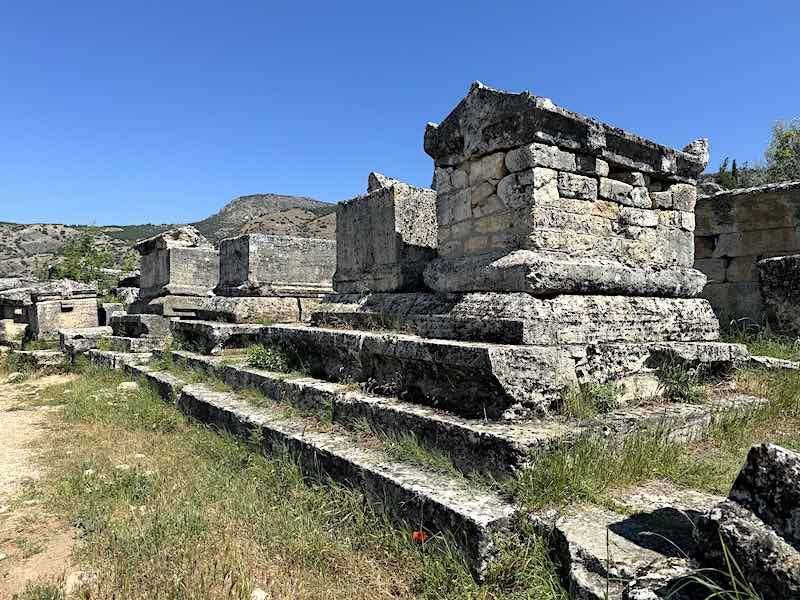
A few of the limestone stones found in the Greco-Roman necropolis of Hierapolis
This necropolis is one of the best-preserved in Turkey, featuring approximately 1,200 limestone tombs. While most tombs date back to the late Hellenic period, many are from the Roman and early Christian eras.
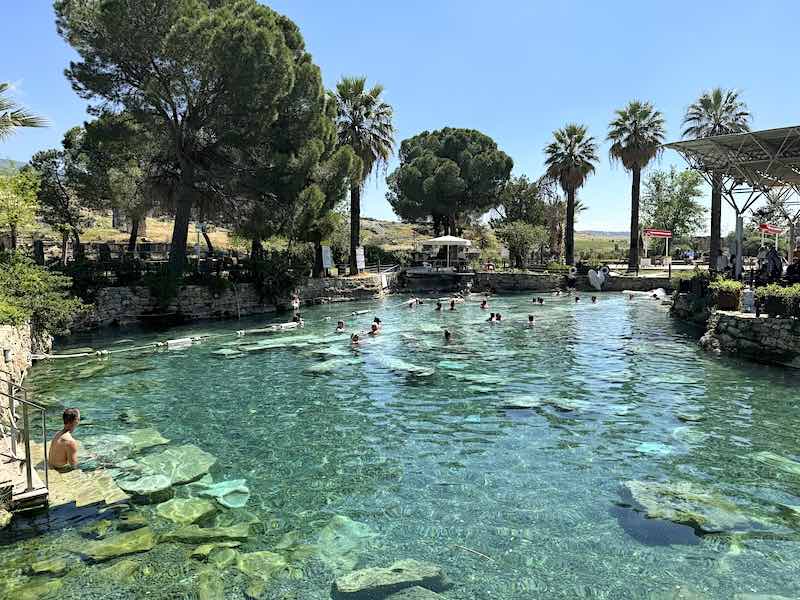
The thermal waters of Cleopatra’s Pool at Hierapolis featuring submerged fragments of columns
In addition to experiencing the thermal waters flowing through the travertine terraces of Pamukkale, the most enjoyable attraction is the thermal antique pool, commonly known as Cleopatra’s Pool. Although numerous legends suggest that Cleopatra bathed in this pool, there is no conclusive evidence to support this claim. It is likely a captivating tale designed to attract tourists. Today, visitors can swim in the warm thermal waters, maintained at around 100º F (38º C), surrounded by the remains of a marble portico adorned with Ionic columns that collapsed into the spring during an earthquake in the 7th century AD.
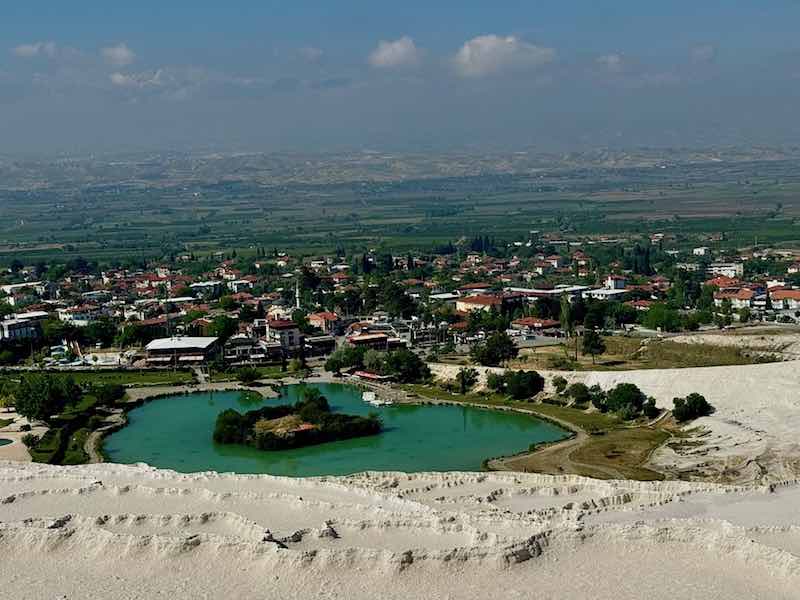
The view from the travertine terraces of Pamukkale overlooking the hotels and town below
It is highly probable that Pamukkale will be among your destinations in southern Turkey. Your entry ticket grants access to both Pamukkale and Hierapolis. Many visitors typically spend just enough time to stroll along the travertine terraces of Pamukkale and briefly immerse their feet in the waters.
To fully appreciate the site, consider setting aside extra hours to explore the Roman ruins of Hierapolis, and do not forget to pack your swimsuit for a refreshing swim in the warm waters of Cleopatra’s Pool.
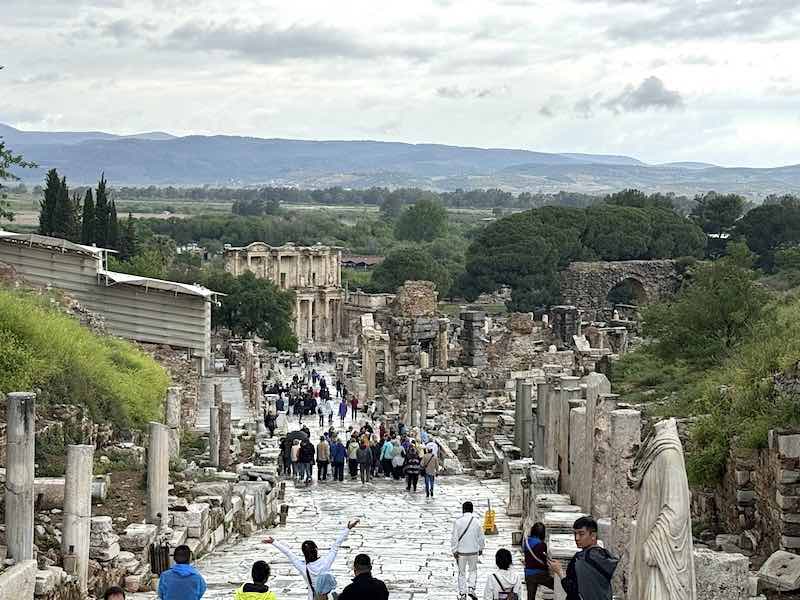
The lower end of the Curetus Way with the Library of Celsus featured in the distance
Ephesus
Any trip to southern Turkiye will likely include a visit to the historic city of Ephesus. This site offers a wealth of attractions, as its excavated remnants date back to classical Greece and the Roman Empire, during which it served as the primary commercial hub of the Mediterranean, as well as the early spread of Christianity.
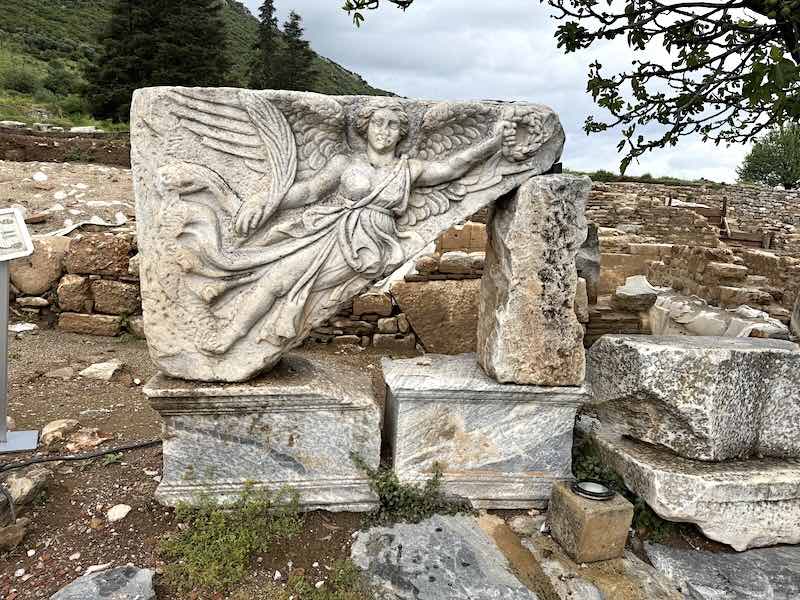
A stone carving of the goddess Nike in Ephesus
Ephesus thrived as a city adorned with opulent decorations that showcased the affluence of its residents. It is famously known from ancient Greek times as the site of the magnificent Temple of Artemis, recognized as one of the Seven Wonders of the Ancient World; regrettably, only a single, unremarkable reconstructed column remains today.
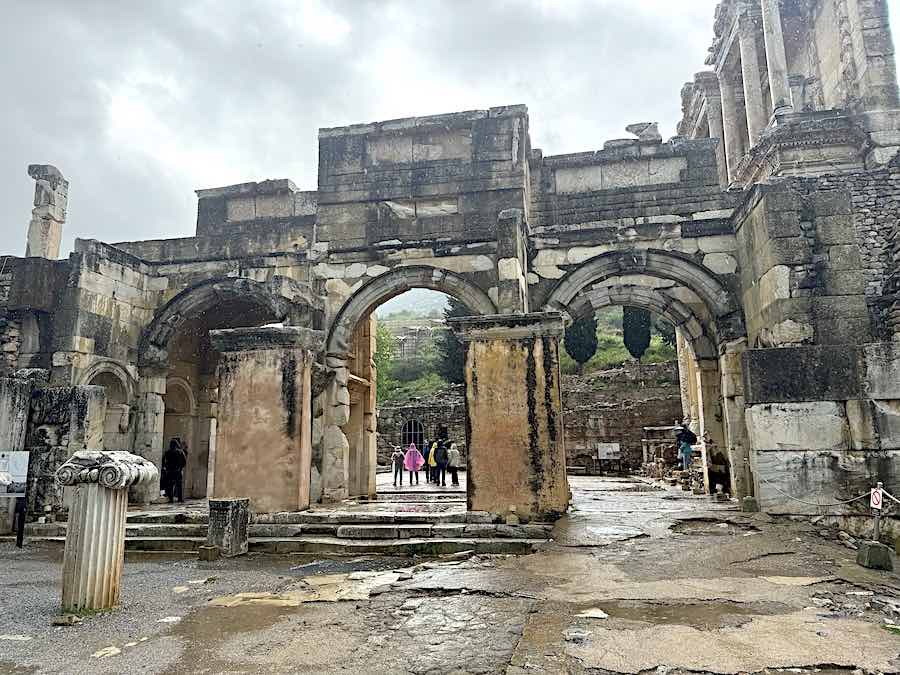
The Gate of Mazeus and Mithridates which leads (also know as the Gate of Augustus) into the courtyard in front of the Celsus Library
Ephesus fell under Roman control in 133 BC and became the capital of Asia Minor in 27 BC. It is often regarded as the second most significant city in the Roman Empire, following Rome itself. Additionally, Ephesus holds considerable importance in Christian history, as it is believed that St. Paul composed the “First Letter to the Corinthians” here, and St. John is thought to have authored his Gospel in this city.
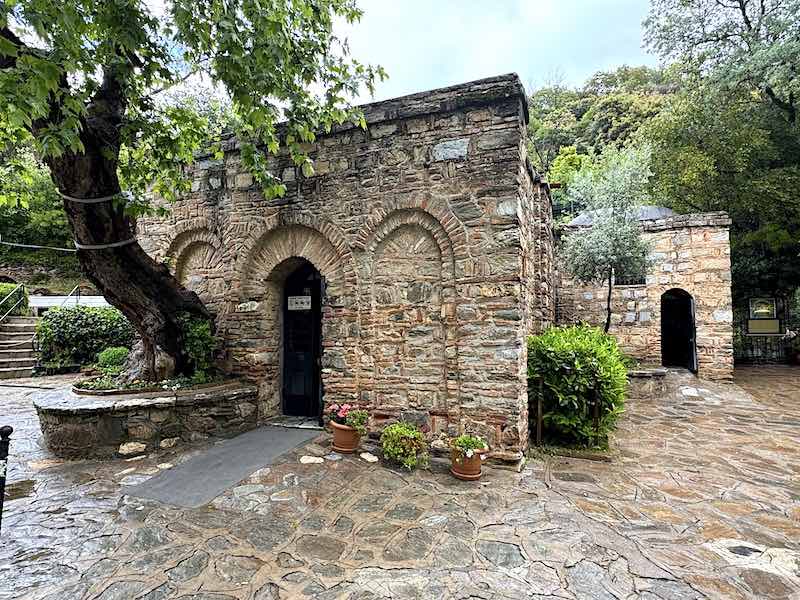
The House of the Virgin Mary on Mt. Koressos, located just outside the ancient ruins of Ephesus
Furthermore, Ephesus is believed to be Mary’s final resting place, with St. Mary’s Basilica being one of the most frequented sites. Presently, Ephesus is a hub of extensive archaeological excavation and research, with new findings emerging each year. Our travel group had the chance to explore Ephesus on a rainy spring day.
Since the rain was intermittent, it allowed us to navigate most of the city; however, the sporadic downpours made our experience quite wet. As is customary for many tour groups, we commenced our journey at the House of the Virgin Mary, located just outside the ancient ruins on Mt. Koressos.
This site attracts numerous pilgrims who believe that Mary, the mother of Jesus, was brought to this stone dwelling by John the Apostle and resided there for the remainder of her life. As we approached the conclusion of our visit to the stone structure, a heavy downpour ensued, accompanied by lightning.
Notably, one lightning strike occurred near the visitor center, resulting in a complete power outage for the complex. It was challenging to determine whether this was merely an unfortunate start or if the Roman Gods were delivering a portent prior to our exploration of Ephesus.
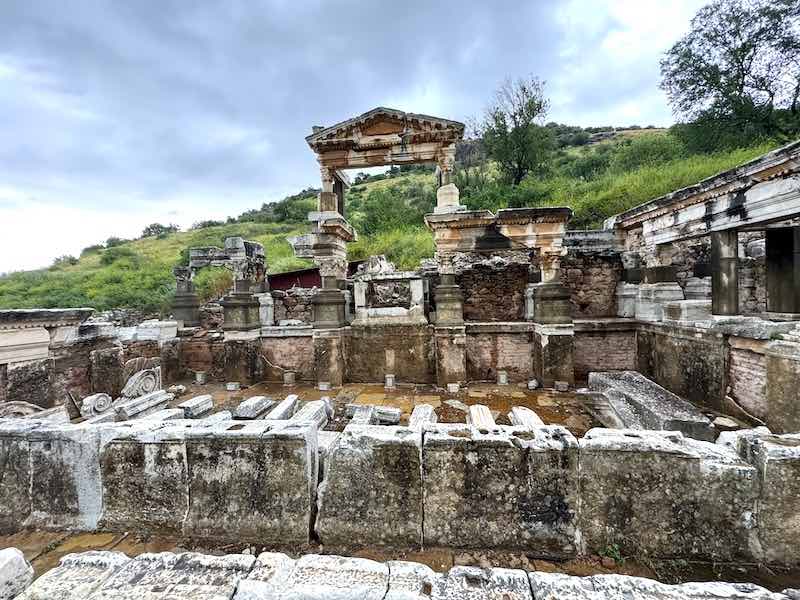
A fountain dedicated to the Roman Emperor Hadrian located along the Curetes Way in Ephesus
Ephesus is located along the Aegean Sea. Its main thoroughfare ascends from the coastline, where many significant landmarks are positioned at higher elevations above the port. We commenced our journey at the hill’s summit and made our way down towards the harbor.
The archaeological excavations and restorations at Ephesus are more comprehensive than those found at most ancient sites in the eastern Mediterranean. The ruins that are visible allow visitors to envision the city’s former grandeur.

Columns on the east end of the Basilica Stoa at Ephesus
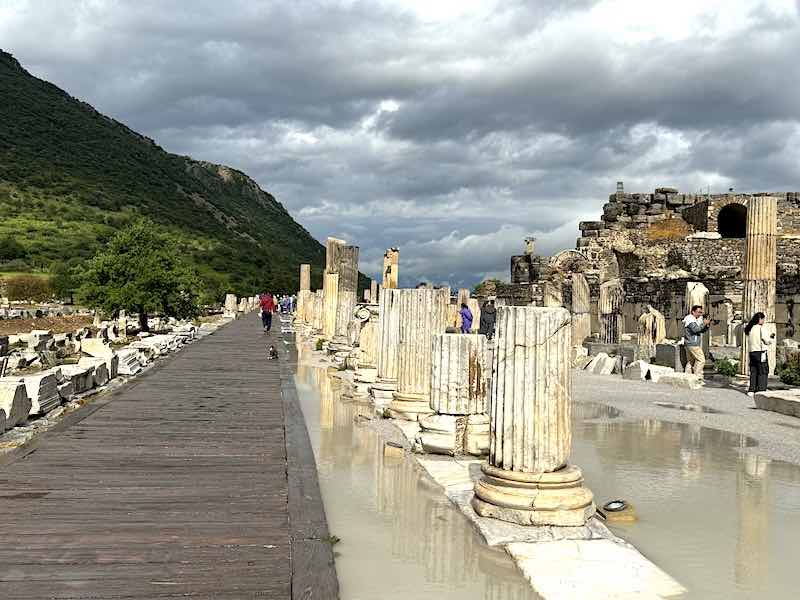
Remnants of the colonnade of the Basilica Stoa in Ephesus
As we descended along the Curetes Way, an almost 700-foot (213 m) main avenue adorned with statues, religious and civic buildings, prominent residences, shops, shrines, fountains, and even dining establishments, we relished the journey to the port while exploring sections of the reconstructed structures, all the while admiring the Library of Celsus before us.

A Roman public toilet facility along the Curetes Way
Regrettably, heavy rains commenced during our descent after visiting an impressive Roman toilet facility.
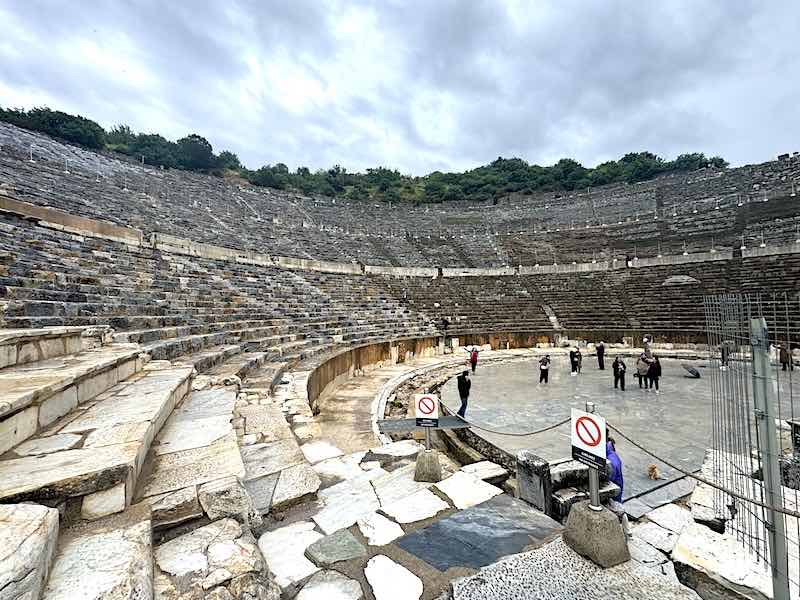
The Great Theater at Ephesus which seated around 10,000 spectators

A small Hellenistic fountain from the 2nd Century AD found on a corner of the Grand Theater facing the Harbor Street
The downpour persisted as we toured the renowned library until we arrived at the theater. Navigating the slick stones and becoming soaked while attempting to appreciate some of the more iconic structures was far from enjoyable, even with adequate rain gear.
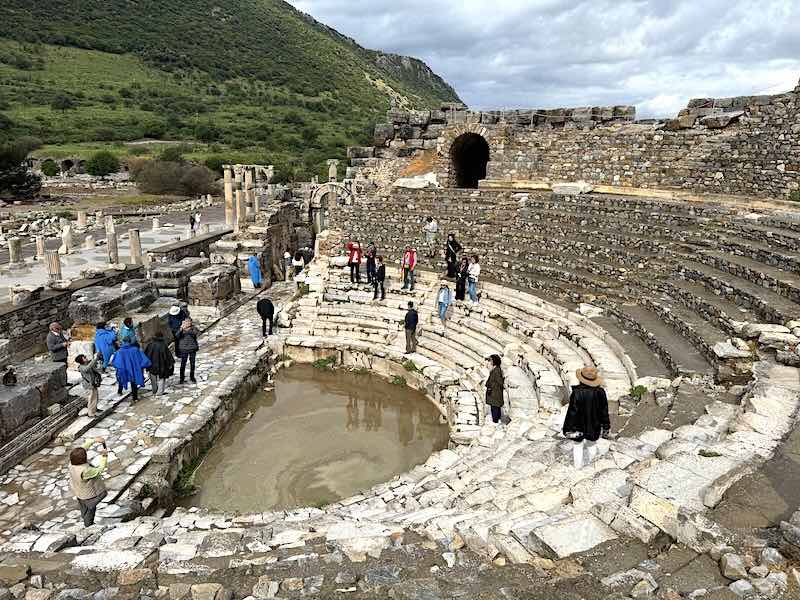
The Ephesus Bouleuterion or Odeon used for lectures and discussions
I experienced multiple slips and pondered whether it was truly worth risking my safety for the sake of tourism and memorable photographs. Ephesus offers a wealth of attractions, and a visit can easily extend for several hours to explore notable sites such as the Odeon, the Temple of Hadrian, the Temple of Domitian, the Grand Theater, various fountains, shrines, and other significant monuments.
Currently, terrace houses are being excavated, revealing the lifestyle of affluent residents during the Roman Empire. During our visit, the Theater of Ephesus was undergoing reconstruction, and the Via Mare, which connects the port to the theater, was also being restored.
While all sites remained accessible, scattered stones awaited replacement, and large cranes and construction equipment were prevalent throughout the area. In the nearby city of Selçuk, the Ephesus Archaeological Museum houses approximately 64,000 artifacts from Ephesus. Its most famous exhibit is ancient statues of the Greek Goddess Artemis, which were recovered from nearby Ephesus.

The facade of the Celsus Library, one of the most famous sites along the Curetes Way in Ephesus
Ephesus is an essential destination, though it frequently experiences heavy foot traffic from day tours originating from cruise ships. It is advisable to arrive early and to hope for favorable weather conditions. Should you receive a sign from the Roman gods, as we did, plan carefully and bring non-slip footwear.
Other Options
If you find yourself in the southern Anatolian region of Türkiye, numerous options are available for exploring the remnants of ancient Greco-Roman cities. It is advisable to carefully consider your group’s specific interests and capacity for exploration.
It can be very valuable to discuss preferences with your group. In addition to the four archaeological sites we visited, several other significant locations may possess unique features of interest.
Your itinerary will likely include Ephesus and Pamukkale, for which you should allocate a full day each. Subsequently, reflect on the types of Roman structures that would appeal to your group members and the various settings that might enhance their experience.
The region is home to numerous other Roman cities worth exploring. For those seeking a Roman archaeological site that offers a stunning view of the Aegean Sea, Assos is an excellent choice, renowned for its theater and the Temple of Athena, which overlooks the blue waters of the Aegean.
Another remarkable site with a sea view is Knidos, celebrated for its gently sloping streets, stoas, colonnaded thoroughfare, theater, Temple of Apollo, and early Christian churches. There are several sites that rival the size of Ephesus but attract significantly fewer visitors.
Aphrodisias is particularly noted for its monumental gateway, the Temple of Aphrodite, a 1,750-seat Bouleuterion (council house), theater, and an impressive stadium complex. It is one of the rare sites that can showcase a stadium used for athletic competitions and chariot racing.
Additionally, Kaunos stands out as a large site featuring both Roman and Hellenistic architecture, including the Temple of Apollo, a theater, Roman baths, a Byzantine basilica, a residential area, and Hellenistic rock tombs.
For groups searching for a unique experience, the town of Termessos, famous for its rock-cut tombs and remarkably preserved theater, presents an outstanding option. Should their interests include sculpture, Didyma boasts remarkable sculptured reliefs along its Sacred Way and within the Temple of Apollo.
Furthermore, investing in knowledgeable, passionate guides is highly advisable, as they can effectively convey the importance of foundational structures, temple remnants, mosaic floors, ceremonial arches, colonnades, sports complexes, and theaters. These Greco-Roman cities were once thriving communities, and gaining insight into the lives of their residents and the operational dynamics of the city through an engaging narrative can elevate a simple collection of stones into a meaningful living experience.

An ancient statue of the Greek Goddess Artemis from the 2nd Century AD found at Ephesus currently displayed at the Ephesus Archaeological Museum in Selçuk, Türkiye
Conclusion
The southern Anatolian region of Türkiye offers an abundance of sites featuring Roman ruins. With numerous significant locations to explore, it is easy to become overwhelmed by the desire to visit them all.
It is also easy to fall into the trap of solely focusing on a single prominent site such as Ephesus. It is crucial to recognize that not all members of your group may share the same enthusiasm, and some may quickly succumb to what is often referred to as “antiquities fatigue.”
By thoughtfully selecting sites that cater to your party’s interests and emphasizing each location’s distinctive features, you can create an experience that appeals to everyone. Careful planning can transform your journey into a memorable historical adventure rather than a tedious slog through a series of ancient stones and bricks.


 Travel to Turkey – Ephesus, Pamukkale, Hieropolis, Izmir – Video Episode 17
Travel to Turkey – Ephesus, Pamukkale, Hieropolis, Izmir – Video Episode 17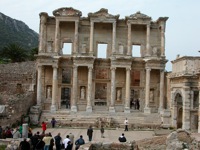 Turkey, Asia – Episode 82
Turkey, Asia – Episode 82 3 Great Places to Visit in Turkey
3 Great Places to Visit in Turkey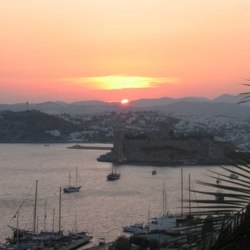 Travel to Bodrum, Turkey – Episode 271
Travel to Bodrum, Turkey – Episode 271
